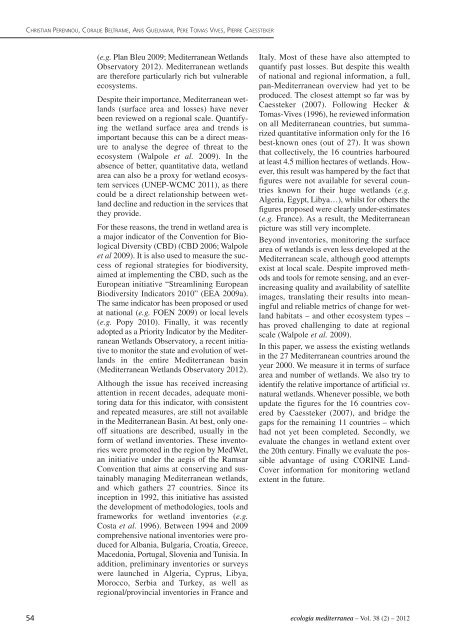Ecologia Mediterranea
Ecologia Mediterranea
Ecologia Mediterranea
Create successful ePaper yourself
Turn your PDF publications into a flip-book with our unique Google optimized e-Paper software.
CHRISTIAN PERENNOU, CORALIE BELTRAME, ANIS GUELMAMI, PERE TOMAS VIVES, PIERRE CAESSTEKER<br />
54<br />
(e.g. Plan Bleu 2009; <strong>Mediterranea</strong>n Wetlands<br />
Observatory 2012). <strong>Mediterranea</strong>n wetlands<br />
are therefore particularly rich but vulnerable<br />
ecosystems.<br />
Despite their importance, <strong>Mediterranea</strong>n wetlands<br />
(surface area and losses) have never<br />
been reviewed on a regional scale. Quantifying<br />
the wetland surface area and trends is<br />
important because this can be a direct measure<br />
to analyse the degree of threat to the<br />
ecosystem (Walpole et al. 2009). In the<br />
absence of better, quantitative data, wetland<br />
area can also be a proxy for wetland ecosystem<br />
services (UNEP-WCMC 2011), as there<br />
could be a direct relationship between wetland<br />
decline and reduction in the services that<br />
they provide.<br />
For these reasons, the trend in wetland area is<br />
a major indicator of the Convention for Biological<br />
Diversity (CBD) (CBD 2006; Walpole<br />
et al 2009). It is also used to measure the success<br />
of regional strategies for biodiversity,<br />
aimed at implementing the CBD, such as the<br />
European initiative “Streamlining European<br />
Biodiversity Indicators 2010” (EEA 2009a).<br />
The same indicator has been proposed or used<br />
at national (e.g. FOEN 2009) or local levels<br />
(e.g. Popy 2010). Finally, it was recently<br />
adopted as a Priority Indicator by the <strong>Mediterranea</strong>n<br />
Wetlands Observatory, a recent initiative<br />
to monitor the state and evolution of wetlands<br />
in the entire <strong>Mediterranea</strong>n basin<br />
(<strong>Mediterranea</strong>n Wetlands Observatory 2012).<br />
Although the issue has received increasing<br />
attention in recent decades, adequate monitoring<br />
data for this indicator, with consistent<br />
and repeated measures, are still not available<br />
in the <strong>Mediterranea</strong>n Basin. At best, only oneoff<br />
situations are described, usually in the<br />
form of wetland inventories. These inventories<br />
were promoted in the region by MedWet,<br />
an initiative under the aegis of the Ramsar<br />
Convention that aims at conserving and sustainably<br />
managing <strong>Mediterranea</strong>n wetlands,<br />
and which gathers 27 countries. Since its<br />
inception in 1992, this initiative has assisted<br />
the development of methodologies, tools and<br />
frameworks for wetland inventories (e.g.<br />
Costa et al. 1996). Between 1994 and 2009<br />
comprehensive national inventories were produced<br />
for Albania, Bulgaria, Croatia, Greece,<br />
Macedonia, Portugal, Slovenia and Tunisia. In<br />
addition, preliminary inventories or surveys<br />
were launched in Algeria, Cyprus, Libya,<br />
Morocco, Serbia and Turkey, as well as<br />
regional/provincial inventories in France and<br />
Italy. Most of these have also attempted to<br />
quantify past losses. But despite this wealth<br />
of national and regional information, a full,<br />
pan-<strong>Mediterranea</strong>n overview had yet to be<br />
produced. The closest attempt so far was by<br />
Caessteker (2007). Following Hecker &<br />
Tomas-Vives (1996), he reviewed information<br />
on all <strong>Mediterranea</strong>n countries, but summarized<br />
quantitative information only for the 16<br />
best-known ones (out of 27). It was shown<br />
that collectively, the 16 countries harboured<br />
at least 4.5 million hectares of wetlands. However,<br />
this result was hampered by the fact that<br />
figures were not available for several countries<br />
known for their huge wetlands (e.g.<br />
Algeria, Egypt, Libya…), whilst for others the<br />
figures proposed were clearly under-estimates<br />
(e.g. France). As a result, the <strong>Mediterranea</strong>n<br />
picture was still very incomplete.<br />
Beyond inventories, monitoring the surface<br />
area of wetlands is even less developed at the<br />
<strong>Mediterranea</strong>n scale, although good attempts<br />
exist at local scale. Despite improved methods<br />
and tools for remote sensing, and an everincreasing<br />
quality and availability of satellite<br />
images, translating their results into meaningful<br />
and reliable metrics of change for wetland<br />
habitats – and other ecosystem types –<br />
has proved challenging to date at regional<br />
scale (Walpole et al. 2009).<br />
In this paper, we assess the existing wetlands<br />
in the 27 <strong>Mediterranea</strong>n countries around the<br />
year 2000. We measure it in terms of surface<br />
area and number of wetlands. We also try to<br />
identify the relative importance of artificial vs.<br />
natural wetlands. Whenever possible, we both<br />
update the figures for the 16 countries covered<br />
by Caessteker (2007), and bridge the<br />
gaps for the remaining 11 countries – which<br />
had not yet been completed. Secondly, we<br />
evaluate the changes in wetland extent over<br />
the 20th century. Finally we evaluate the possible<br />
advantage of using CORINE Land-<br />
Cover information for monitoring wetland<br />
extent in the future.<br />
ecologia mediterranea – Vol. 38 (2) – 2012
















